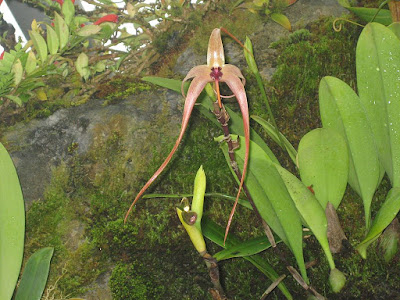Bulbophyllum echinolabium is native to Sulawesi (Celebes). The orchid was discovered near Donggala, a town on the west coast of the peninsula, which separates southern Sulawesi from the northern Minahassa peninsula...
Bulbophyllum echinolabium also called as The Bulbophyllum with the Hedge-Hog Shaped Lip, is a species of the genus Bulbophyllum. This species was described by Johannes Jacobus Smith in 1934.
IDENTIFY BULBOPHYLLUM ECHINOLABIUM
Bulbophyllum echinolabium is native to Sulawesi (Celebes). The orchid was discovered near Donggala, a town on the west coast of the peninsula, which separates southern Sulawesi from the northern Minahassa peninsula. They grow in in riverine to primary forests at elevations of 600 to 1200 meters.
It is an unifoliate, medium sized, epiphytic species with 1.8 to 3.5 cm between each ovoid, non-angular pseudobulb and carrying a single, apical, elliptic to obovate, rounded, gradually narrowing below into the elongate petiolate base leaf.
The Bulbophyllum with the Hedge-Hog Shaped Lip blooms on a basal, 70 cm long, successively, single flowered inflorescence that slowly extends with up to 10, unpleasant smelling flowers, occurring in the spring and summer. The flowers grow in cultivation are up to 40 cm, counting from the end of the dorsal petal to the ends of the side petals of the outer whorl. The first flower described by J.J. Smith, however, was only 22 cm long. The petals of both whorls are pink and crimson, while the elongated, sharp tip is orange.
BULBOPHYLLUM ECHINOLABIUM CARE AND CULTURE
Cultural information should only be used as a guide, and should be to be adapted to suit you. Your physical location; where you grow your plants, how much time you have to devote to their care, and many other factors, will need to be taken into account. Only then can you decide on the cultural methods that best suit you and your plants.
Light:
Bulbophyllum echinolabium needs a light level of 18000-30000 lux. The light should be filtered and dispersed, and the plants should not be exposed to the direct sunlight of the midday sun. Strong air movement should be ensured all the time. The plant should be carefully observed and if necessary change the level of light to higher or lower, depending on the needs of the plant. (If the leaves turn red or burn, the plant needs to be moved to a slightly darker place, but if the plant fails to flower, the light level should be increased).
Temperature:
It is a thermophilic plant. Throughout the year, the average day temperature is 27-28 ° C, and the average night temperature is 19-21 ° C, which gives a daily amplitude of 7-8 ° C.
Humidity:
The Bulbophyllum with the Hedge-Hog Shaped Lip needs the humidity of around 80% throughout the year.
Substrate, growing media and repotting:
Bulbophyllum echinolabium require excellent drainage and good air circulation around the roots, so they are usually planted into very flat pots or baskets and apply a very loose, quickly drying ground. Different amounts of humectant additives, such as perlite or pieces of peat moss, can be mixed with a basic material consisting of small to medium sized pieces of pine bark or tree fern. The woody fern fibers are especially recommended because they do not decompose as quickly as pieces of pine bark, which means that it is not necessary to repot too often.
This species do not like the violation of the roots and sometimes they get sick for up to one year or more to separate pseudobulbs or repotting. If the substrate has not decomposed but the plant has grown out of the container, you can transfer the plant with the entire root ball to a larger container without disturbing the roots. If repotting is necessary, make sure that new roots are already beginning to grow. This allows the plant to rooting as quickly as possible. The plants should, however, be repotted immediately after finding out that the substrate has decomposed.
Watering:
Bulbophyllum echinolabium should be abundantly watered during active growth, with slight drying between waterings. However, do not allow the substrate to become stale or soaked.
Fertilizer:
During the active growth, the plants should be fertilized every week 1/4-1/2 of the recommended dose of fertilizer for orchids. From spring to mid-summer, you can use fertilizer enriched with nitrogen, then switching to phosphorus-enriched fertilizer in late summer and autumn.
Rest period:
In winter, the amount of water should be slightly reduced, especially if Bulbophyllum echinolabium are grown under dark, short days, which occurs at moderate latitudes. However, these plants should never be dried. If the amount of water supplied decreases, fertilization should also be reduced until new increments are created in spring.















COMMENTS